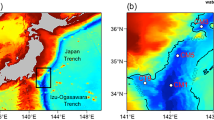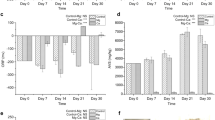Abstract
Humic acids are one of the main organic matters in sediments and contribute importantly to the marine biogeochemical cycles. Extracellular electron transfer is a ubiquitous natural process and has potentials to change the macrostructure of humic acids which can act as an electron shuttle. By setting up marine sediment microbial fuel cells, the present study revealed that enhanced extracellular electron transfer process could increase the content of C and H, but decrease the O content in humic acids, which could result in an increased aromaticity and decreased polarity of humic acids, whereas no significant changes occurred to the humification degree of the humic acids. Specific bacterial groups as potential exoelectrogens including Proteobacteria (especially Pseudomonas strains) and Firmicutes were enriched under enhanced extracellular electron transfer process, indicating that they were active to exchange electrons and might play important roles during the changes of humic acids, while the relative abundance of Verrucomicrobia and Bacteroidetes was reduced during these processes. The results of the present research shed lights on the relation between exoelectrogens and the transformation of humic acids in coastal sediment, while the microbial process and mechanisms behind it require further study.





Similar content being viewed by others
References
Abate G, Masini JC (2005) Influence of pH, ionic strength and humic acid on adsorption of Cd(II) and Pb(II) onto vermiculite. Colloid Surface A 262:33–39
Abbas SZ, Rafatullah M, Khan MA, Siddiqui MR (2019) Bioremediation and electricity generation by using open and closed sediment microbial fuel cells. Front Microbiol 9:3348
Akaighe N, Maccuspie RI, Navarro DA, Aga DS, Banerjee S, Sohn M, Sharma VK (2011) Humic acid-induced silver nanoparticle formation under environmentally relevant conditions. Environ Sci Technol 45:3895–3901
Aulenta F, Maio VD, Ferri T, Majone M (2010) The humic acid analogue antraquinone-2,6-disulfonate (AQDS) serves as an electron shuttle in the electricity-driven microbial dechlorination of trichloroethene to cis-dichloroethene. Bioresource Technol 101:9728–9733
Bauer I, Kappler A (2009) Rates and extent of reduction of Fe(III) compounds and O2 by humic substances. Environ Sci Technol 43:4902–4908
Cai WJ, Iii GWL, Cornwell JC, Giblin AE (2010) Carbon cycling and the coupling between proton and electron transfer reactions in aquatic sediments in Lake Champlain. Aquat Geochem 16:421–446
Chai X, Hao Y, Liu G, Li Z, Zhao Y (2013) The effect of aerobic conditions on the complexation ability between mercury and humic acid from landfill leachate and its implication for the environment. Chemosphere 92:458–463
Chang CH, Wei CC, Lin LH, Tu TH, Liao HC (2016) Humic acids enhance the microbially mediated release of sedimentary ferrous iron. Environ Sci Pollut R 23:4176–4184
Chen J, Gu B, Leboeuf EJ, Pan H, Dai S (2002) Spectroscopic characterization of the structural and functional properties of natural organic matter fractions. Chemosphere 48:59–68
Cieslewicz J, Gonet SS (2004) Properties of humic acids as biomarkers of lake catchment management. Aquat Sci 66:178–184
Coates JD, Cole KA, Chakraborty R, O’Connor SM, Achenbach LA (2002) Diversity and ubiquity of bacteria capable of utilizing humic substances as electron donors for anaerobic respiration. Appl Environ Microb 68:2445–2452
Coles CA, Yong RN (2006) Humic acid preparation, properties and interactions with metals lead and cadmium. Eng Geol 85:26–32
Cozzolino A, Conte P, Piccolo A (2001) Conformational changes of humic substances induced by some hydroxy-, keto-, and sulfonic acids. Soil Biol Biochem 33:563–571
Giovanela M, Crespo JS, Antunes M et al (2010) Chemical and spectroscopic characterization of humic acids extracted from the bottom sediments of a Brazilian subtropical microbasin. J Mol Struct 981:111–119
Hargitai L (1994) Biochemical transformation of humic substances during humification related to their environmental functions. Environ Int 20:43–48
Hassan H, Jin B, Donner E et al (2018) Microbial community and bioelectrochemical activities in MFC for degrading phenol and producing electricity: microbial consortia could make differences. Chem Eng J 332:647–657
Hubert M, Bosch J, Griebler C (2016) Long-distance electron transfer by cable bacteria in aquifer sediments. ISME J 10:2010–2019
Kang S, Xing B (2008) Humic acid fractionation upon sequential adsorption onto goethite. Langmuir the Acs Journal of Surfaces Colloids 24:2525–2531
Kotloski NJ, Gralnick JA (2013) Flavin electron shuttles dominate extracellular electron transfer by Shewanella oneidensis. Mbio 4:169–172
Lee S, Kim DH, Kim KW (2017) The enhancement and inhibition of mercury reduction by natural organic matter in the presence of Shewanella oneidensis MR-1. Chemosphere 194:515–522
Li M, Zhou M, Tian X et al (2018) Microbial fuel cell (MFC) power performance improvement through enhanced microbial electrogenicity. Biotechnol Adv 36:1316–1327
Lovley DR (2012) Long-range electron transport to Fe(III) oxide via pili with metallic-like conductivity. Biochem Soc T 40:1186–1190
Lovley DR, Fraga JL, Coates JD, Blunt-Harris EL (2010) Humics as an electron donor for anaerobic respiration. Environ Microbiol 1:89–98
Monzon O, Yang Y, Kim J, Heldenbrand A, Li Q, Alvarez PJJ (2017) Microbial fuel cell fed by Barnett Shale produced water: power production by hypersaline autochthonous bacteria and coupling to a desalination unit. Biochem Eng J 117:87–91
Nepomnyashchaya YN, Slobodkina GB, Baslerov RV, Chernyh NA, Bonchosmolovskaya EA, Netrusov AI, Slobodkin AI (2012) Moorella humiferrea sp. nov., a thermophilic, anaerobic bacterium capable of growth via electron shuttling between humic acid and Fe(III). Int J Syst Evol Microbiol 62:613–617
Piccolo A, Spaccini R, Drosos M, Vinci G, Cozzolino V (2018) Chapter 4—the molecular composition of humus carbon: recalcitrance and reactivity in soils. In: The future of soil carbon. Wiley, pp 87–124
Piepenbrock A, Schröder C, Kappler A (2014) Electron transfer from humic substances to biogenic and abiogenic Fe(III) oxyhydroxide minerals. Environ Sci Technol 48:1656–1664
Rabaey K, Boon N, Siciliano SD, Verhaege M, Verstraete W (2004) Biofuel cells select for microbial consortia that self-mediate electron transfer. Appl Environ Microb 70:5373–5382
Ramasamy RP, Gadhamshetty V, Nadeau LJ, Johnson GR (2010) Impedance spectroscopy as a tool for non-intrusive detection of extracellular mediators in microbial fuel cells. Biotechnol Bioeng 104:882–891
Rocker D, Brinkhoff T, Grüner N, Dogs M, Simon M (2012) Composition of humic acid degrading estuarine and marine bacterial communities. FEMS Microbiol Ecol 80:45–63
Romarís-Hortas V, Moreda-Piñeiro A, Bermejo-Barrera P (2007) Application of microwave energy to speed up the alkaline extraction of humic and fulvic acids from marine sediments. Anal Chim Acta 602:202–210
Schlesinger WH (1997) Biogeochemistry: an analysis of global change, 2nd edn. Houston, Texas
Stedmon CA, Bro R (2008) Characterizing dissolved organic matter fluorescence with parallel factor analysis: a tutorial. Limnol Oceanogr-Meth 6:572–579
Stevenson FJ (1994) Humus chemistry. Genesis, composition, reactions, 2nd edn. Wiley, New York
Thygesen A, Poulsen F, Min B, Angelidaki I, Thomsen A (2009) The effect of different substrates and humic acid on power generation in microbial fuel cell operation. Bioresour Technol 99:1186–1191
Tokunou Y, Hashimoto K, Okamoto A (2016) Acceleration of extracellular electron transfer by alternative redox active molecules to riboflavin for outer-membrane cytochrome C of Shewanella oneidensis MR-1. J Phys Chem C 120(29):16168–16173
Torres CI, Marcus AK, Lee HS, Parameswaran P, Krajmalnikbrown R, Rittmann BE (2010) A kinetic perspective on extracellular electron transfer by anode-respiring bacteria. FEMS Microbiol Rev 34:3–17
Wang K, Xing B (2005) Structural and sorption characteristics of adsorbed humic acid on clay minerals. J Environ Qual 34:342
Wang D, Bradford SA, Harvey RW, Gao B, Cang L, Zhou D (2012) Humic acid facilitates the transport of ARS-labeled hydroxyapatite nanoparticles in iron oxyhydroxide-coated sand. Environ Sci Technol 46:2738
Wang Z, Zheng Y, Xiao Y, Wu S, Wu Y, Yang Z, Zhao F (2013) Analysis of oxygen reduction and microbial community of air-diffusion biocathode in microbial fuel cells. Bioresour Technol 144:74–79
Wang Z, Lee T, Lim B, Choi C, Park J (2014) Microbial community structures differentiated in a single-chamber air-cathode microbial fuel cell fueled with rice straw hydrolysate. Biotechnol Biofuels 7:9
Xu F, Cao F, Kong Q et al (2018) Electricity production and evolution of microbial community in the constructed wetland-microbial fuel cell. Chem Eng J 339:479–486
Yang Y, Xu M (2019) Bioelectroremediation of Sediments. In: Wang AJ, Liang B, Li ZL, Cheng HY (eds) Bioelectrochemistry stimulated environmental remediation. Springer, Singapore
Yang Y, Shu L, Wang X, Xing B, Tao S (2011) Impact of de-ashing humic acid and humin on organic matter structural properties and sorption mechanisms of phenanthrene. Environ Sci Technol 45:3996
Zabihallahpoor A, Rahimnejad M, Talebnia F (2015) Sediment microbial fuel cells as a new source of renewable and sustainable energy: present status and future prospects. RSC Adv 5:94171–94183
Zeng YH, Jiao NZ, Cai HY, Chen XH, Wei CL (2004) Phylogenetic diversity of ribulose-1,5-bisphosphate carboxylase/oxygenase large subunit genes of bacterioplankton in the East China Sea. Acta Oceanol Sin 23:673–685
Zhang J, He M, Shi Y (2009) Comparative sorption of benzo[alpha]phrene to different humic acids and humin in sediments. J Hazard Mater 166:802–809
Acknowledgements
This work was supported by the National Key Research and Development Program of China (2016YFA0601402), the Open Task of Qingdao National Laboratory for Marine Science and Technology (Grant no. QNLM2016ORP0311), 2017 President’s International Fellowship Initiative of the Chinese Academy of Sciences (CAS PIFI 2017VCA0019) supported the contribution of Robina Farooq, QIBEBT and Dalian National Laboratory For Clean Energy (DNL), CAS (Grant: QIBEBT ZZBS 201805).
Author information
Authors and Affiliations
Contributions
Zejie Wang and Jiulong Zhao carried out the experiment and wrote the paper. Long Wang contributed to bioinformatics and statistical analysis. Lili Tang, Rui Ren, and WuxinYou helped to carry out the DNA extraction, elemental analysis, and FT-IR analysis. Robina Farooq and Yongyu Zhang contributed to the experimental design and data analysis. All authors participated in the interpretation of the results, critically revising manuscripts, and approving the final manuscript.
Corresponding author
Ethics declarations
Conflict of interest
The authors declare that they have no conflict of interest.
Additional information
Communicated by Erko Stackebrandt.
Publisher's Note
Springer Nature remains neutral with regard to jurisdictional claims in published maps and institutional affiliations.
Rights and permissions
About this article
Cite this article
Zhao, J., Wang, L., Tang, L. et al. Changes in bacterial community structure and humic acid composition in response to enhanced extracellular electron transfer process in coastal sediment. Arch Microbiol 201, 897–906 (2019). https://doi.org/10.1007/s00203-019-01659-3
Received:
Revised:
Accepted:
Published:
Issue Date:
DOI: https://doi.org/10.1007/s00203-019-01659-3




